La jolla beach vacation rentals
La Jolla Beach Vacation Rentals is a company that specializes in providing vacation rentals to the La Jolla area. They have been providing rental services for over 30 years and have helped thousands of people enjoy their time on the beach.
La Jolla Beach Vacation Rentals offers rentals both individually and in groups of three or more people. Their properties are located in the heart of San Diego, so you can walk to everything you need during your stay. They also offer free WiFi, which is important because many of their customers work from home.
They offer a wide range of homes, from small studios to large houses with three bedrooms. Each property has its own unique personality, but all are decorated with stylish furnishings and well-appointed bathrooms. The homeowners are friendly and helpful if there are any questions about the property or about San Diego itself that might interest visitors who aren’t familiar with this area.
La jolla beach vacation rentals
Black’s Beach
Why go: To surf or enjoy some quiet (note that some people still go nude here).
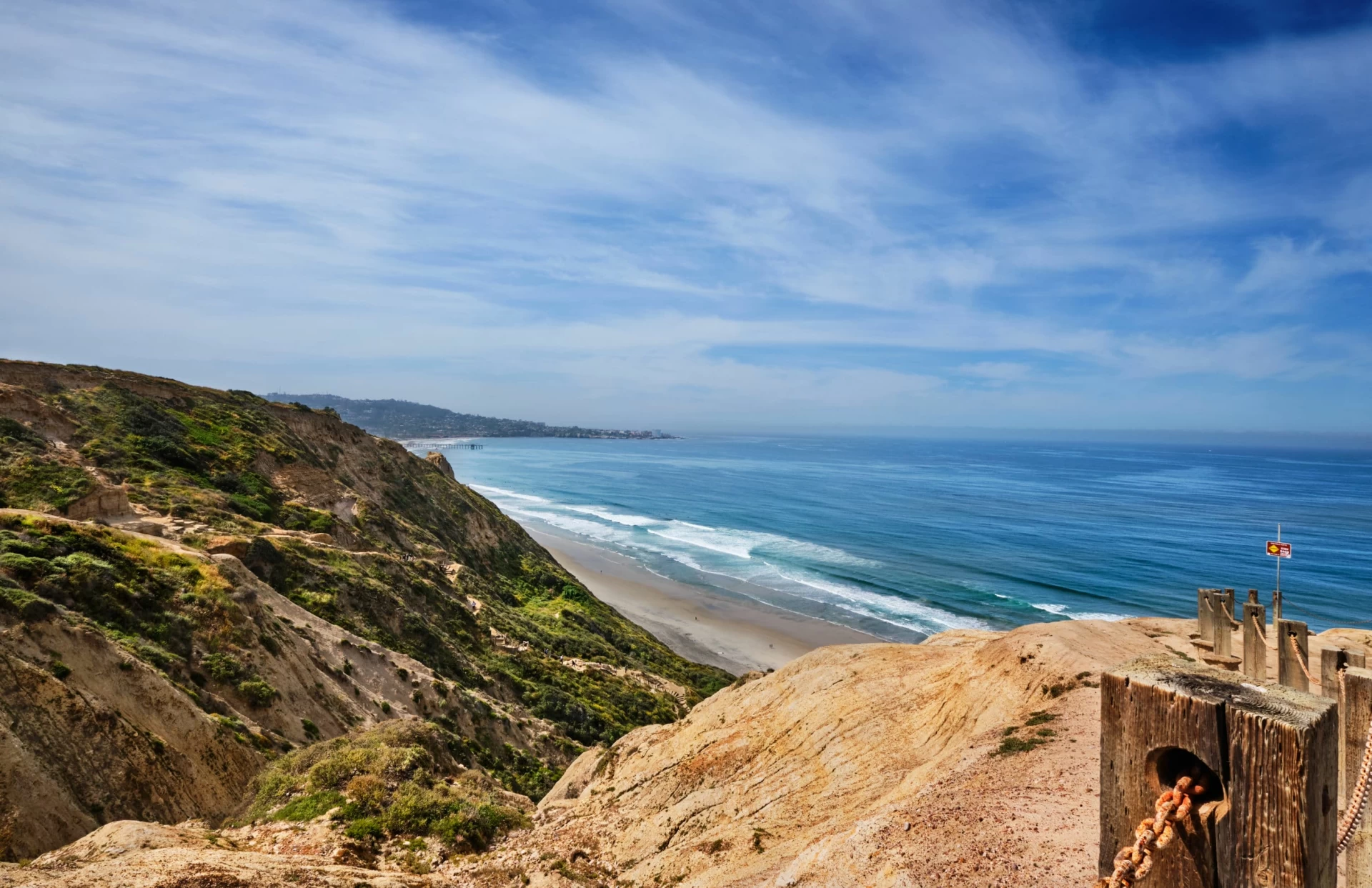
Black’s Beach La Jolla is a secluded section of beach beneath the bluffs of Torrey Pines, and is officially part of Torrey Pines State Beach. Black’s Beach is perhaps most notorious for its status as San Diego’s only nude beach, though that’s no longer allowed in the more southern portion managed by the City of San Diego.
Black’s Beach was named for the Black family who owned a horse farm overlooking the beach in the 1940s. They eventually sold the land and it was divided into several La Jolla Farms lots. The Farms’ residents were the only ones who retained access to the Black family’s private road to the beach, which at that time was a highly coveted secret. You can still see many of these mansions today—look for the oddly-shaped “Mushroom House” and its matching funicular next time you’re strolling along the beach.
The southern portion of Black’s Beach is well known to surfers as one of the most powerful surf breaks in Southern California. The waves gain their power from Scripps Canyon, an underwater canyon just offshore in the San Diego-La Jolla Underwater Park. Because of this, Black’s has become a pretty dangerous surfing location and is only advised for very experienced surfers. There is a permanent lifeguard stationed here that is staffed year-round.
Parking and how to get there: Black’s Beach can be difficult to access due to its location (directly below the Torrey Pines bluffs), though currently there are four access routes to Black’s Beach. You can park in the La Jolla Shores neighborhood, enter the beach, and keep walking north until you find it but the most popular is the Gliderport Trail.
La Jolla Shores Beach
Why go: This the best La Jolla beach for all-day sunbathing, family fun and a wide range of water sports. In fact, it’s one of the best San Diego beaches if not the best.
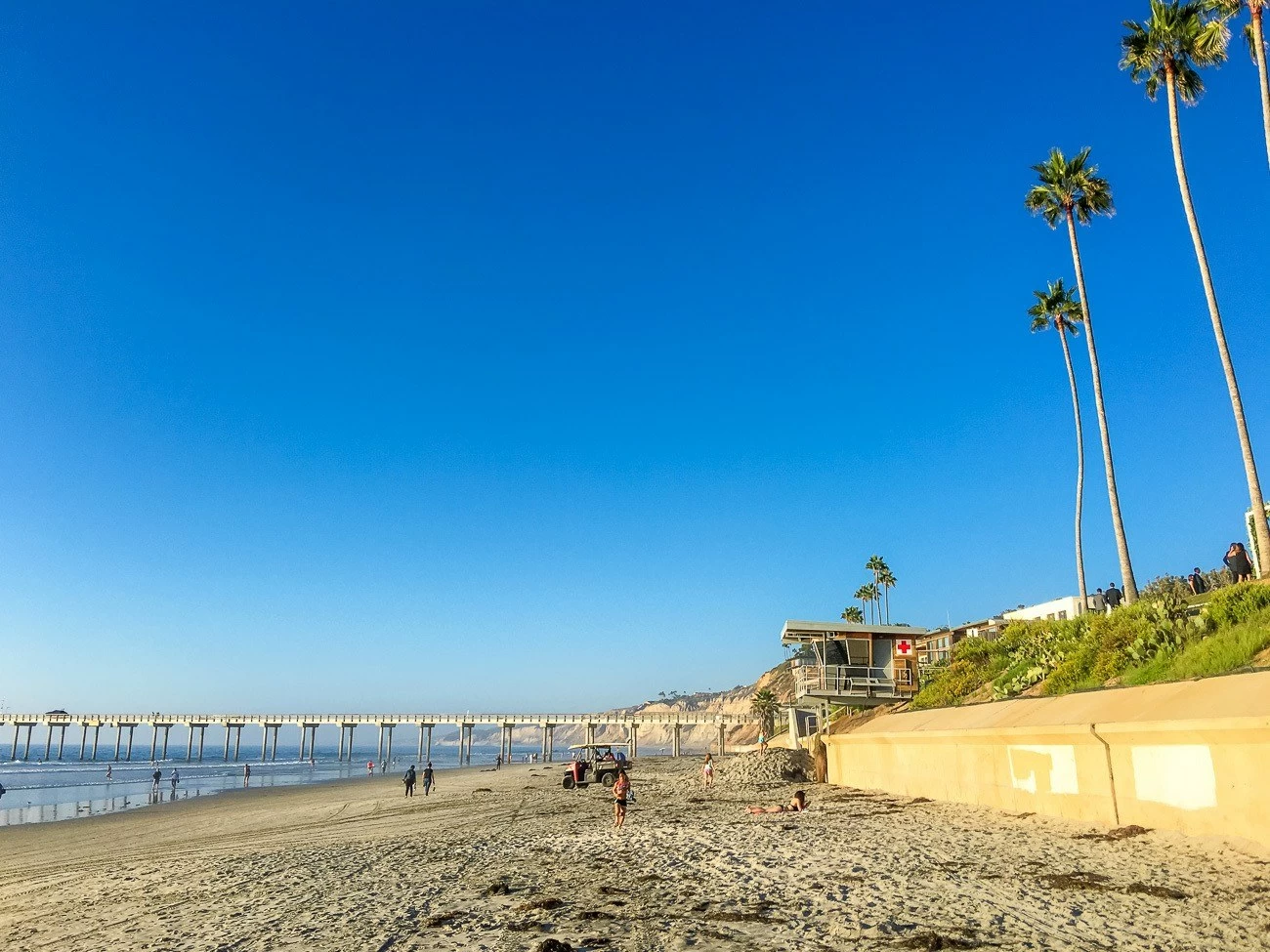
La Jolla Shores Beach is a 1-mile long stretch of beach that sits just south of the Village (downtown La Jolla). This beach is particularly great for families with small kids, surfers, and kayakers.
It’s the only kayak launch spot in La Jolla, and its long, flat sandy shore makes for a pretty easy takeoff point for most water sports. You should plan to take a La Jolla kayak tour of our seven sea caves departing from here. If you’d like to learn how to take surfing lessons in La Jolla, this is the spot.
The beach is comfortable and makes for a great picnic spot, with plenty of grassy area at nearby Kellogg Park. There is also a large playground area for kids, as well as bathrooms and showers, fire pits, and volleyball courts. If you’re heading out here for a bonfire, keep in mind you should get there early to reserve a pit. They go extremely fast, especially in the summer.
Our La Jolla Beach hotels, La Jolla Beach and Tennis Club and La Jolla Shores Hotel, are both located next to each other on the sand here. There is also a state-of-the-art permanent lifeguard station near the hotels, Kellogg Park and the public parking lot.
You’re also within walking distance of the local shops and restaurants on Avenida de la Playa.
Fun fact: During the summer, La Jolla Shores beach is where the largest aggregation of leopard sharks in the world happens. You can also see stingrays (it’s wise to shuffle your feet when entering the ocean to scurry them away) and other rare sea life you wouldn’t see elsewhere depending on the season.
Parking and how to get there: La Jolla Shores Beach is easily accessible from Torrey Pines Road and La Jolla Shores Drive. A large parking lot is located at 8300 Camino Del Oro; there is also plenty of street parking in the nearby neighborhoods.
La Jolla Cove Beach
Why go: It’s one of the best La Jolla beaches because of easy entry into the ecological reserve for snorkeling and diving, a nice though small strip of sand for sunbathing (which can get crowded in good weather), and the La Jolla sea lions who call this stretch of beach home.
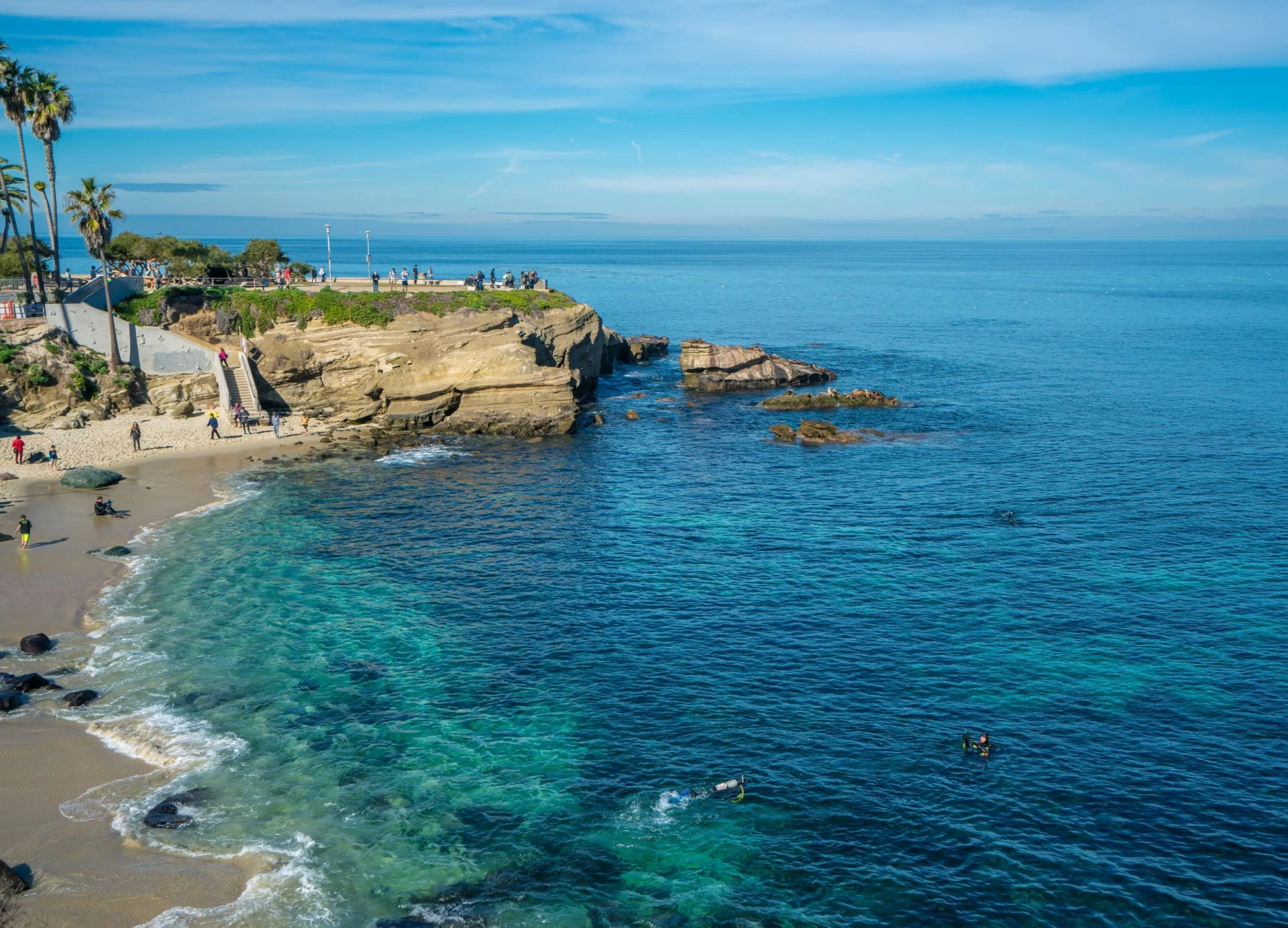
La Jolla Cove is arguably what our little seaside town is known for. The Cove remains protected as part of the San Diego-La Jolla Underwater Park Ecological Reserve, meaning it’s home to an incredible variety of marine life and therefore popular with snorkelers, swimmers and scuba divers.
The swells that roll in from the open ocean here can be relatively forceful along the edges of beautiful La Jolla Cove, so swimmers here are typically more experienced. The water temperature is also often a little colder than the average San Diego beach. Unlike other La Jolla beaches nearby, the dry sand area is very small at high tide. During low tides, however, some great La Jolla tide pools are revealed.
It’s still a relatively popular spot for swimming, San Diego snorkeling and scuba diving, despite some trouble with pollution in recent years. It’s also home to many open water swimming events year round, including the Rough Water Swim.
However, surfers, beware. Because La Jolla Cove is within the Underwater Park, swimming devices like surfboards, boogie boards, and kayaks aren’t allowed. All sea animals are strictly protected here. Keep an eye out for the bright orange Garibaldi fish (California’s state fish), which is unusually common in the area.
Fun fact: The water temperature in here is almost always cooler than in other areas of San Diego’s coastline because it faces out into much deeper, colder, water. If you plan on tide pooling or swimming, be sure to check the tides and water temperature first.
Parking and how to get there: La Jolla Cove Beach is located at 1100 Coast Blvd. Parking is typically difficult as the Cove is incredibly popular, but street parking is generally your best bet.
La Jolla Cove hotels: One of my frequently asked questions where to stay in La Jolla near La Jolla Cove. My two favorites are La Valencia Hotel (across the street) and Grande Colonial (a few blocks away). They are both located on Prospect Street.
Boomer Beach
Why go: It’s popular for bodysurfing and views from the walkway above and adjacent to La Jolla Cove.

Boomer Beach is located just to the west of Ellen Browning Scripps Park and south of the Cove. It’s one of the smaller, lesser known beaches in La Jolla, and its exposure to stronger Pacific Ocean waves and currents makes it less popular than neighboring Cove.
This is an extremely popular body surfing spot because of the powerful waves and the fact that surfing and boogie boarding are prohibited. It’s for experts and those familiar with the currents and terrain, not for the casual body surfer.
If you’re looking to get away from the summer crowds, Boomer’s is also ideal for soaking in some rays as it’s typically less busy.
Parking and how to get there: There are no stairs down to the beach, so your best bet is to scramble down the sandstone bluffs to reach the sand. Like most other spots along Coast Blvd., parking is usually problematic so plan to circle a few times before you find a spot.
Shell Beach
Why go: For winter tide pooling and a quick walk along a small beach.
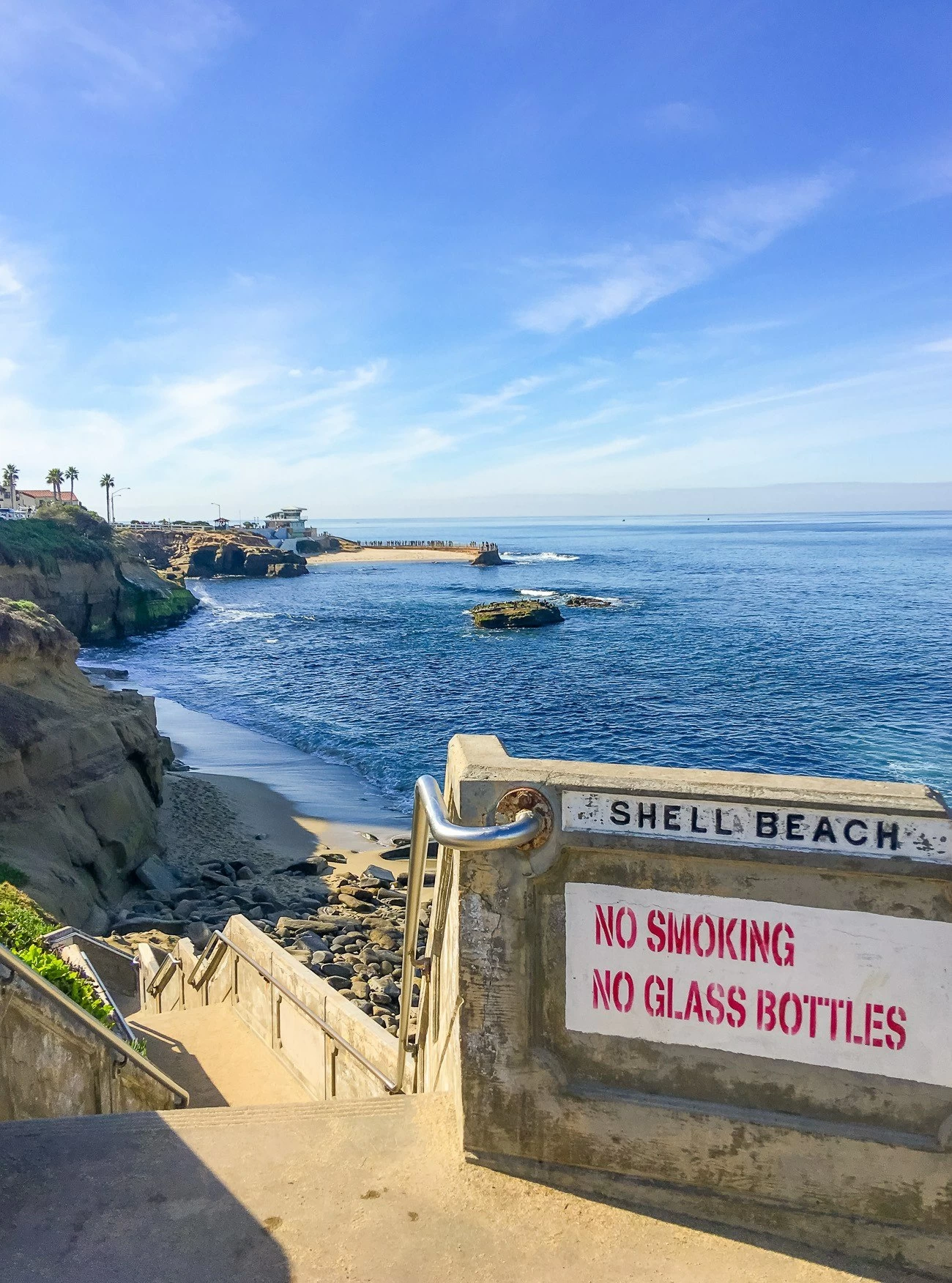
Shell Beach is a small beach located just south of Ellen Browning Scripps Park (right across the grass from La Jolla Cove) and north of Children’s Pool. It can be accessed only by a flight of concrete stairs. Look for the engraved “Shell Beach” sign in the concrete above.
The beach is more commonly known as a hidden gem tide pooling spot. An incredible variety of marine life is showcased on the southern end during low and minus tides—just look for the rocky, flat area.
A pathway along the bluff goes north through the park and continues to the Coast Walk Trail. Seal Rock is just offshore and Children’s Pool Beach is visible beyond that to the south.
Parking and how to get there: Shell Beach parking can be a challenge, but is allowed all along Coast Blvd. and in designated spaces.
Children’s Pool Beach
Why go: To see the famous La Jolla seals and walk on the sea wall.

Children’s Pool Beach, located close to downtown La Jolla and walking distance from La Jolla Cove, is a small cove protected by a concrete breakwater seawall. Ellen Browning Scripps herself donated the funds for the seawall in 1931, envisioning it as a safe space for children to play and swim out of harm’s way.
Before it was built, there was a shallow water area between a large rock and a mainland bluff called Seal Rock Point; the sea wall was built on top of several rocks and topped by a paved walkway protected by railings. Though swimming is strongly discouraged now due to high levels of bacteria in the water, the walkway is still open to the public and makes for one-of-a-kind views of the surrounding seascape and Seal Rock.
The beach area has been fully claimed by seals and sea lions for years now, and while swimming is technically still allowed, it’s discouraged to protect the seals. You’ll still see them lounging on the sand, and the area closes for a few months every year to respect pupping season, roughly between December 15 and May 15.
Parking and how to get there: Children’s Pool beach is located at 850 Coast Blvd., and your best bet is to find street parking along the coast. There is no official lot, though there are some designated parking spaces along the street.
South Casa Beach
Why go: You’re at the Children’s Pool and would like to step out on the sand to explore a different beach.
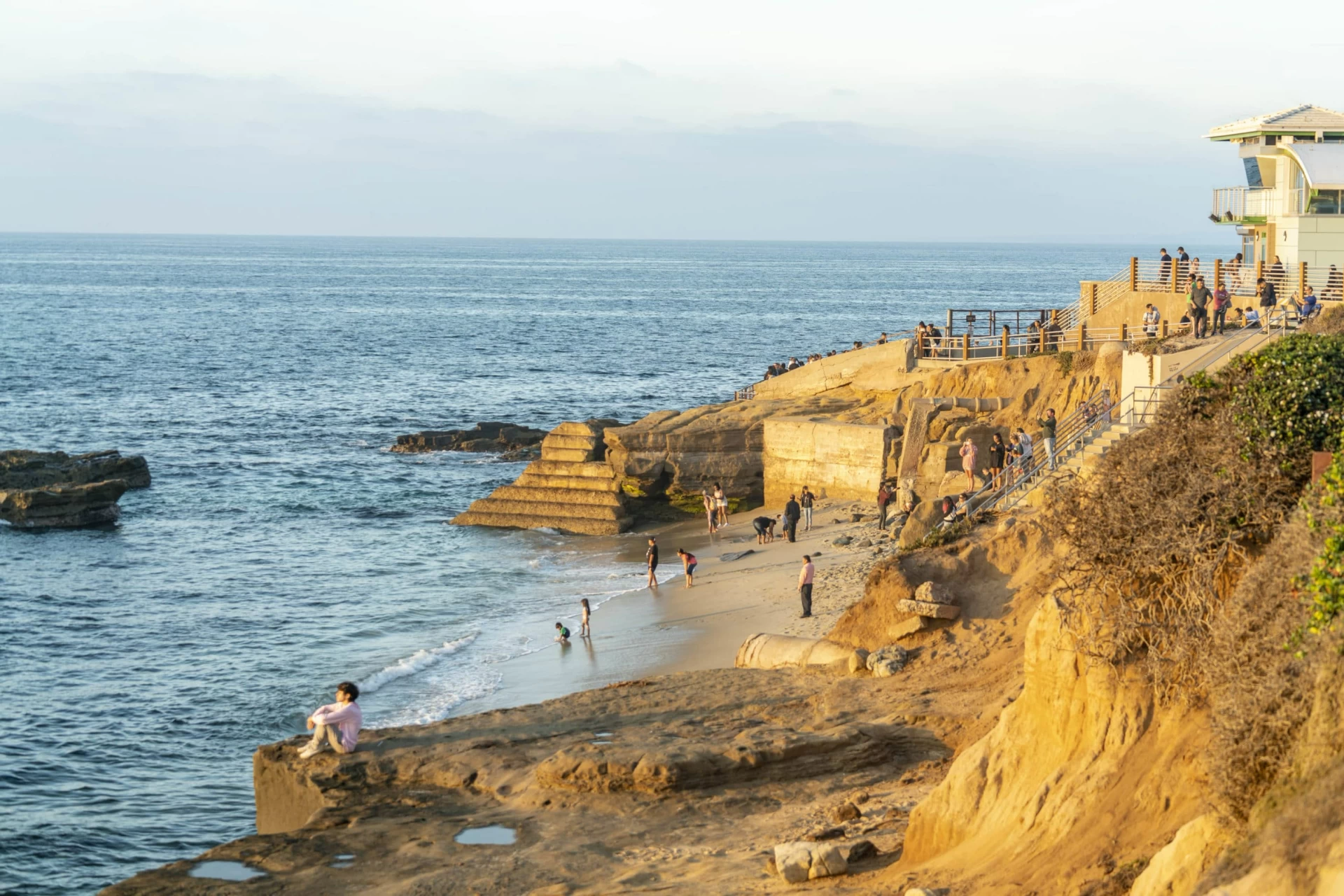
South Casa Beach is located directly south of the Children’s Pool (which is also referred to as Casa Beach). In fact, it’s just on the other side of the Children’s Pool lifeguard station, which also services South Casa Beach.
Use the walkway down from the boardwalk to access this La Jolla beach which is a mini cove with excellent tide pools in winter. You’ll see people sunbathing on the sand here during other times of the year. Swimming isn’t recommended to do proximity to the sea wall and rocks but people like to play at the water’s edge.
Parking and how to get there: Use the free parking along Coast Blvd. and surrounding residential areas.
Wipeout Beach
Why go: You’re taking a nice long walk along the Village beaches or looking for seclusion.
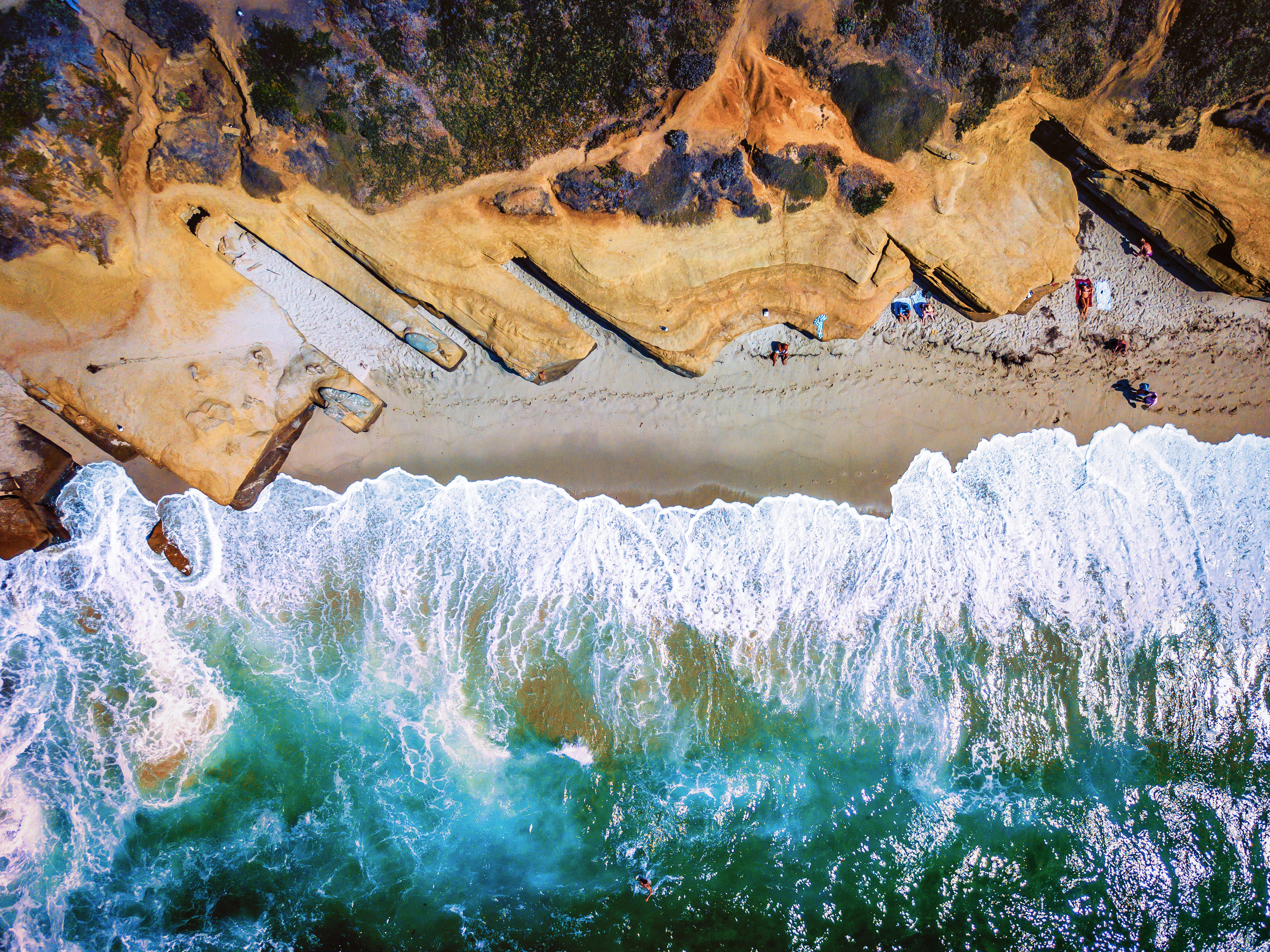
Wipeout Beach is located on the 700 block of Coast Blvd., and is a sandy stretch of beach just south of South Casa Beach and the Children’s Pool. It’s a great spot for sunbathing, but again isn’t recommended for inexperienced swimmers because of the rip current. Low tide is probably the best time to visit this spot, as there’s more sand to walk along and you’ll be able to see a few shallower exposed tide pools.
There are a few small caves along the shoreline that you can explore from Wipeout, but unfortunately they’re usually blocked by seaweed and other debris. If you’re lucky enough to see an opening and are feeling adventurous, just be aware of the incoming tide and wave size.
Just up the stairs from this beach are public restrooms, showers, and a lifeguard station. It’s an easy walk to Ellen Browning Scripps Park and other beaches in the area.
Parking and how to get there: Some free parking is available along Coast Blvd. and a few paid lots are within walking distance of the beach.
Marine Street Beach
Why go: To experience a quiet, local favorite and to surf.
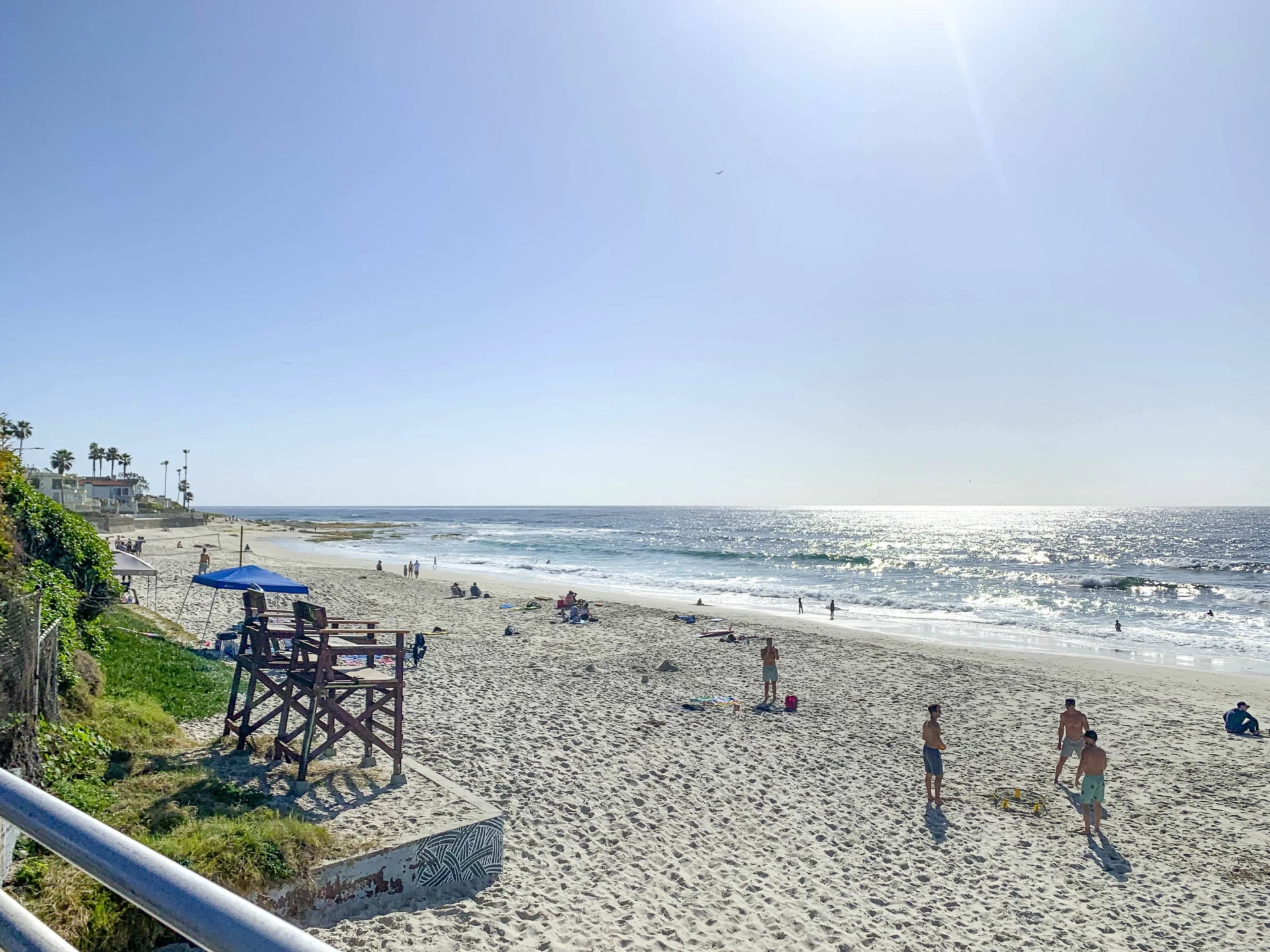
Marine Street is one of the best La Jolla beaches because it’s a wide, white sand beach that sits just between two rock reef points, Little Point and Horseshoe. The surf here is famous for being rough and unpredictable, making it popular with surfers and bodyboarders but not advisable for inexperienced swimmers. Unfortunately, due to that, it’s also been the site of countless injuries and rescues.
Marine Street has a long history of being a strictly locals only beach. Though not as bad as some beaches in the area, fierce hometown loyalty is alive and well here. Years ago, surfers wrote the words “Locals Only” on the center wall at the beach. It isn’t always visible, but locals will occasionally rewrite it from time to time. Keep an eye out for the two oversized beach chairs just to the left as you walk down the stairs. They’ve been there for years and make for a great photo op. There is also a volleyball net that my daughter and her friends use.
Fun fact: It’s a popular spot for photographers, and many famous ocean photographers have shot here; most notably, Clark Little.
Parking and how to get there: Just follow Marine Street down until you reach the shoreline. Street parking is available on both cross streets. Many locals tend to park just in front of the barriers before the stairs down to the beach (technically, the curbs are red and you should know that our parking enforcement is aggressive so I don’t recommend this). There are no public restrooms here.
Windansea Beach

Windansea Beach—most well known for its surfing—is a stretch of coastline in the heart of La Jolla. It has a colorful history, and has been a storied favorite of surfers since the 1960s.
Its name comes from the oceanfront Windansea Hotel, which was originally built in 1909 when it was simply called the Strand Hotel. Sadly, it burned down in 1943, but the beach maintained its title.
Fun fact: The distinguishing landmark at Windansea is a palm-covered shack that was originally constructed in 1946 by three surfers: Woody Ekstrom, Fred Kenyon, and Don Okey.
The Surf Shack was officially designated as a historical landmark by the San Diego Historical Resources Board in May of 1998. The shack was destroyed by a high tide in 2015 but was rebuilt by locals.
Parking and how to get there: The Windansea parking lot is located along Neptune Place, between Nautilus and Bonair Streets. Although recently upgraded by the City, it offers only a limited number of parking spaces; luckily, street parking is almost always available. There are no drinking fountains, showers or public restrooms here.
Tips for Enjoying the Best La Jolla Beaches
Lifeguards are stationed at Black’s Beach, La Jolla Shores, La Jolla Cove and the Children’s Pool year-round. You’ll also see seasonal lifeguard towers sprinkled in during peak summer beach going season on these beaches and a few other smaller beaches.
Leashed dogs are allowed at La Jolla beaches during certain hours depending on the time of year. Dogs, other than service animals, are NOT allowed on the beach, boardwalk or adjacent parks between 9:00 a.m. and 4:00 p.m. from November 1 through March 31 and between 9:00 a.m. and 6:00 p.m. from April 1 through October 31.
Some beaches are divided into swimming and surfing zones. A black and yellow checkered flag serves as the dividing point and usually accompanies signage to indicate where each is allowed.
Beware of our lovely seagulls as they are known to fly away with paper and plastic bags and whatever is inside of them.
Beachgoers may not smoke, bring glass containers, or drink alcohol on our public beaches. There is one exception to the booze rule in La Jolla but you must be a member or guest of the La Jolla Beach and Tennis Club to drink on their small stretch of private beach.
Wear sunscreen even if there is cloud cover. Also, be mindful of rip currents.